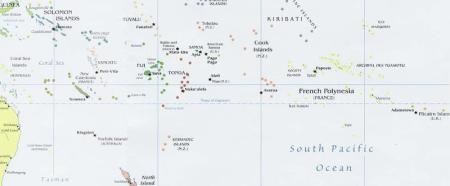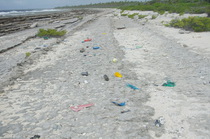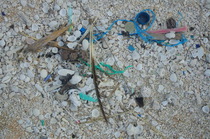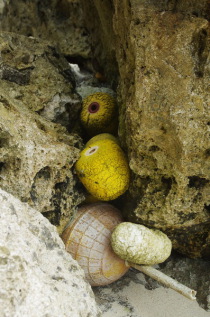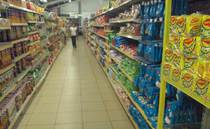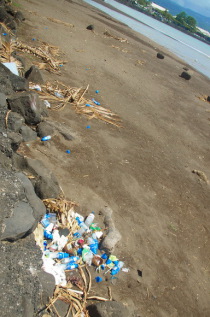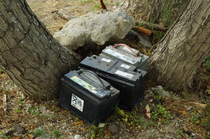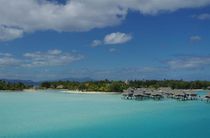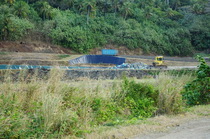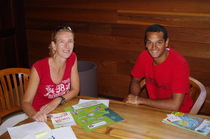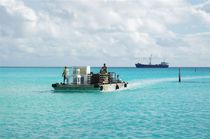COPLARE on Waste in Oceania
2014-07_PACIFIC ISLANDS_COPLARE on Waste[...]
PDF-Dokument [954.2 KB]
Waste in Oceania. Oceania? My atlas does not know any Oceania and in the German geography classes we did not learn about this term during our school days. Who else but honeymooners might be interested in the South Sea Islands? Do they have any relevance for the global structure?
Oceania in the strictest sense are the islands lying between the west coast of the United States and Australia south of the equator: the Easter Island and Pitcairn, the Marquesas, Tuamotus, the Society, Gambier and the Austral Islands, the Cook Islands, Niue, Samoa, Tonga, Fiji, Vanuatu, New Caledonia as well as the Solomon Islands. Strictly speaking, the islands of Micronesia, Papua New Guinea and New Zealand also belong to Oceania but we will ignore them for now in order to make it easier for us.
Between Panama and Sydney there are 14.000 km of water where several thousand islands are spread. For the purpose of comparison: Frankfurt to Bangkok means only about 9.000 km. and within the national territory of French Polynesia, the island Nuku Hiva (Marquesas) is e.g. 1.900 km away from the island Tubuai (Austral Islands). Munich is as far away from Istanbul as Nuku Hiva from Tubuai. The distances between the islands are enormous and most of the islands are tiny. Many of them have only a few hundred inhabitants.
In order to get a clearer idea, just look at the table at the end of this article and keep in mind that this table only maps the most densely populated islands. A total of 17.000 people e.g. live on 48 atolls of the Tuamotus, another 30 atolls are unpopulated. The atolls under French administration are distributed over more than 2 million km², an area larger than Western Europe. In contrast, the land surface of all Tuamotus together only amounts to the approximate size of the municipal area of Berlin. The atolls have a maximum altitude of 5 m; most of them have a flat groundwater bubble on one of the larger Motus which is directly beneath the surface. You have guessed: a fragile ecosystem? That’s exactly what it is!
Take a look at the respective landmasses and assess them in relation with the population. The Tuamotus, those narrow ring atolls have only little landmass and are scarcely populated. The Samoan Savaii on the other hand has a lot of landmass but is also scarcely populated. Thus, Savaii has completely different conditions for waste disposal than the Tuamotus.
827.000 people, distributed to 332 islands having a total surface area of 18.333 km², live in Fiji. In Fiji’s capital Suva there are 75.000 people, in Tahiti’s capital including agglomeration around Papeete approximately 125.000 people. New Caledonia’s capital Nouméa including agglomeration even comes to 164.000 inhabitants. Vanuatu’s capital Efate has 50.000 inhabitants and Samoa’s capital Apia approximately 40.000. The mentioned cities are the only centers with a dense population in the part of Oceania considered by us. There, it is possible to envision a certain waste management; in the rural areas, however, not even with a lot of imagination and good will, neither in Savaii nor in the Tuamotus. But the longer the coastline the higher the probability that waste from the sea is washed up.
In the table, please also pay attention to the political affiliation of the island states. Oceania means a combination of influences from England, France, Chile, USA and New Zealand. That means: different opinions as to how a good waste management looks like and whether Oceania can even afford such a waste management, citation of different practices in the mother countries, language barriers …. Waste disposal in landfills (and not recycling or at least thermal recycling) is the most common practice in all mother countries and the measure of all things for Oceania. All of this has to be kept in mind if you want to judge the waste situation in Oceania.
Let’s begin with the question whether marine waste exists
Indeed, marine waste is also found in Oceania. The South Sea Islands are not situated in one of the five known Garbage Patches, but we also found plastic waste on the beach which was clearly washed ashore. The best evidence photos come from Kauehi, one of the Tuamotu atolls, where we were able to take convincing photos on the outer reef as well as on the coral beach inside the lagoon.
This waste was definitely washed ashore and when this waste is found here, it will with a probability bordering on certainty also be found on the windward shores of other islands of Oceania. Right now it seems to be little and if you only stay on the lee shores you will still have the impression of spending a couple of days in paradise on earth on the South Sea beaches. But this will change with the growing mountains of trash.
Waste finds its way into paradise, relentlessly…
When we turn our attention ashore, in all cities we were able to buy the same packaged goods that we could buy in our domestic supermarkets. And those goods are not only bought by tourists but also by the locals: shampoo in plastic bottles, toothbrushes made of plastic, toothpaste in laminate tubes, chips and bonbons in plastic bags, soft drinks, water, milk and fruit juices in plastic bottles, meat products, sausage products, cheese, rice and noodles shrink-wrapped in plastic foil, toast in plastic bags and so on and so forth. Absolutely standard things and products which everybody is allowed to treat themselves to. For approx. 20 years, the inhabitants of Oceania are given more and more access to packaged consumer goods. And only with goods which make life more comfortable they are able to work in hotels, shops, service agencies, industrial enterprises or for example as craftsmen (this will only work if one does not have to work in the fields for many hours, does not have to build earth ovens and does not have to produce food oneself). The result is waste coming to the islands which constitutes an increasing problem.
Most of the islanders don't know that yet. They do not have any experience with waste, there are no passed on traditions regarding how to handle different kinds of waste. All of the goods in question are desirable and the rich people from industrial countries do also buy them. Even if the islanders do not have any experience with the handling of different waste we still have the impression that the Polynesian and Melanesian societies are considerate of cleanliness. It looks immaculate almost everywhere along the paths and streets and around the houses. The only places where the responsibility for waste seems to decline are the areas where urbanization proceeds and where it is possible to disappear in anonymity. That is exactly the same in Europe.
After a festival, numerous water bottles were left behind on the beach of Apia just like after every festival in Germany. On the main island of Bora-Bora, waste was lying along the street in the wastewater drains just like in many German streams. We already reported about the illegal rubbish dump behind the presidential villa in Vanuatu's capital Efate in our travel diary. The equivalent in Germany does no longer exist.
In Bora-Bora and on some atolls of the Tuamotus, acid batteries were standing on the beach and in Apia during the Teuila festival, an old man fumbled a small AA battery out of his trouser pocket before my very eyes and threw it under a palm tree in front of the government building.
I can not imagine that something like this would still happen in Germany. Conclusion No. 1: illegal waste dumps have disappeared in Germany – however, our parents and grandparents will definitely remember that they were quite usual.– Conclusion No. 2. Word has spread that there are collecting points for problematic waste and conclusion No. 3. Everyday waste is also "lost" by many people in Europe.
A positive aspect worth mentioning is that, in Samoa, all plastic bags handed out at supermarket checkouts have to be biodegradable according to law. The degradation of the bags will definitely work excellently in the hot and muggy climate of Samoa. Fruit and vegetables are mostly bought at the market and if a bag is required then this bag is also biodegradable. However, we did not have the impression that a higher environmental consciousness has developed among the people due to the prohibition of conventional plastic bags. We rather believe that the prohibition of conventional plastic bags primarily results from the fact that the SPREP "Secretariat of the Pacific Regional Environment Programme" is situated in Apia.
SPREP members are the 21 nations of the South Pacific as well as four industrial countries with interests in the South Pacific: Australia, France, USA and New Zealand. The SPREP’s objective is to promote cooperations of the states in the sense of a common environmental protection and to render assistance in order to ensure a sustainable development of the region for today’s and future generations. The SPREP team consists of approx. 80 employees and it commands an annual budget of 22 million USD. Since 2012, Australia and New Zealand have guaranteed multiannual budgets which finally enable the SPREP to also get involved in projects which require support for more than only 12 months. Considering the variety of topics and tasks covered by the SPREP with its resources – which range from "A" as in adaption (meant here is the adaption to changed environmental conditions), to "B" as in "Birds", "Baseline Environment Data" and "Biodiversity" (preservation of biological diversity), …, "E" as in „Environmental Education” and "Environmental Legislation", … "L" as is „Landfill", "M" as in "Marine Pollution" and "Mangrove Task Force", …, to "S" as in "Strengthening Capacity of Meteorology in the Pacific region" and "T" as in "Tourism and Environment", it is clear that the SPREP team shall work great wonders with little money.
Hats off to the SPREP for what it has achieved in terms of waste management from 2008 to 2013 under those conditions:
- A comprehensive handbook „Pacific Waste Education Handbook“ which could be adapted to all developing countries with small amendments
- A waste management strategy for the years 2010 through 2015 for the entire region
- A brochure on the handling of electrical waste which is particularly addressed to journalists
- As well as information sheets
- On the reduction of the amount of waste
- On the handling of used lead acid batteries
- On the handling of toxic/hazardous waste
- On coherences between waste and climatic change
- as well as one on the handling of waste in the tourism sector.
The publications are mainly distributed via the Internet. All informational publications are accessible for everyone interested under https://www.sprep.org/library-information-resource-center/publications.
We think it is most clever that the SPREP has deliberately decided to provide journalists with information and ask them for help in the creation of environmental consciousness. In societies which have not known of any environmental problems until recently this is anything but self-evident. For many of them it is literally „incomprehensible“ of which they are supposed to protect the environment.
Researched Facts
A report of the newspaper "Le Monde" dated January 10th 2013 says that all of the waste on the Austral Island Tubuai has been thrown into a swamp for years. The waste is compressed as soon as the hole is full; then the hole is closed with earth and the next hole is dug. According to the opinion of Tubuai’s inhabitants, this approach has proved to be successful for centuries. Le Monde refers to a study on the water quality near the swamp which was carried out by an independent office. This study furnished proof of exceeded limit values for aluminum, manganese and hydrocarbon. Which initially sounds as if the waste impairs the water quality is not confirmed if you investigate which potential damage actually emanates from aluminum, manganese and hydrocarbon. Those ten inhabitants of the swamp in Tubuai who respond that they had heard rumors about water pollution but that they did not know the facts have demonstrated more common sense than the journalists of Le Monde who have simply taken dubious study results in order to fuel concerns which can unfortunately not be substantiated by the facts delivered by the Environmental Bureau. However, it can still be assumed that it will not remain without consequences for a sound environment if more and more waste is disposed of in illegal waste dumps.
Interesting are three cases in which the controlled waste disposal leads to a massive discontent of the local population.
Tuamotus
A report of the French Senate of December 2008 says that the disposal of waste is possible on the higher islands such as e.g. the Marquesas and the Society Islands, however not on the flat atolls of the Tuamotus and the Gambier islands. This is why waste incineration plants should at least be installed on the larger atolls. This, however, failed because of the communities’ opposition for whom on the one hand, the operating costs of the waste incineration plants were too high and, on the other hand, because they dreaded the pollution of the rainwater, the only source of drinking water of the Tuamotus. On Rangiroa, the largest atoll of the Tuamotus, even the separation of waste was abandoned as soon as it became clear that the transport of the recycling waste would have caused costs in the amount of 50 € / family / year. Thus, the waste is still deposited on uncontrolled waste dumps out of which lightweight waste can easily get into the ocean by means of a gust of wind (or flood). The Senate document refers to six failed projects which would have required an investment in the amount of 6.7 million Euro.
The Senate’s conclusion was that the poverty of the communities in the Tuamotus, on the Gambier and the Austral islands constitutes a massive obstacle for the operation of proper waste disposal plants which would actually be required for the preservation of a clean environment and for the wellbeing of the population. The community budgets consist of 2/3 transfer payments from France and, for the time being, it is not likely that the communities will any time soon be able to improve their budget situation by taxes and duties they can levy themselves.
(Source: http://www.senat.fr/rap/r08-130/r08-13026.html)<< Neues Textfeld >>
Bora-Bora
Bora-Bora is an island with ring atoll sized 40 km² which belongs to the group of the Society Islands in the region French Polynesia which is famous for its wonderful lagoon situated between the main island and the ring atoll. In the overwater bungalows, hotel guests are almost as close to the water as we sailors are but they additionally enjoy the four- to five-star comfort of their first class hotel. It is clear that a lot of waste which has to go somewhere is accumulated due to the overnight stays in more than 900 hotel rooms and bungalows. According to a report of the hotel InterContinental Bora-Bora Resort and Thalasso Spa, the hotel with the highest environmental standards of the island, only 5.1 liters of waste per guest and overnight stay are sent to the disposal site, 78% less than in 2007. That sounds fantastic but 5.1 liters are still a hell of a lot! The mayor of Bora-Bora who has been the president of French Polynesia for years is aware that a sound environment constitutes the basis for the revenues from tourism. Following the recommendation of Tahiti, he initiated the construction of a sanitary landfill site. In the islands' measure of progress, the best you can do in Bora-Bora.
However, the chosen site proved to be a mistake according to internet and media reports. If waste is incinerated there – which is required in order to guarantee the planned operating life of the disposal site – then billows of smoke drift to at least one of the first class hotels in case of certain wind conditions. It is understandable that guests who are prepared to pay 250 to 1.000 Euros per night for their stay in Bora-Bora do not want to have their expensive stay spoilt by stench. In the Maldives e.g. the moneyed visitors of the islands are not confronted with this problem. There is an own island for the entire waste; it simply disappears from vision. Bora-Bora's mayor does not have such an island.
Besides, French Polynesia has actually developed a good waste management system. The politicians know exactly where how much waste is generated (on average approx. 500 kg /inhabitant/year – exactly the amount generated in France and Germany). In Tahiti, they established a waste sorting center which extracts recyclables from the waste stream and leads them to recycling. For hazardous waste, there is a special disposal site, there is separation of waste, campaigns were conducted which should lead to increased composting of organic household waste , there are contests which recompense local communities for the fact that they are collecting recycling materials (the community gets 1 Polynesian Franc for every collected kg of recycling waste, this money can be invested in social projects of their choice) and collecting points for waste glass, aluminum, batteries and waste oil were established.
All of this is good and right but unfortunately too little to be received by the population and to achieve a change in behavior regarding the handling of waste. From our own experience we are able to say that it is really difficult to find the recycling bins in Punaauia/Tahiti (the suburb of Papeete where the marina Taina is situated), in Bora-Bora, in Moorea and in Maupiti. They are unremarkable, hard to be distinguished and too far apart. Even we who definitely attach a lot more importance to the separation of waste then most of the locals and other sailors have often given up and finally put the recyclable waste into bins for residual waste when we were again fed up with dragging our waste around for still more kilometers. If you ask the locals you will usually be told that it does not matter in which bin you put your waste. This is what most of them do too.
In Moorea, there was not even a waste bin at the beach of the anchorage where all sailors go on shore. With a guilty conscience, we have secretly put our waste in the bin of a scientific research institute. And in Marina Taina, we haven’t seen only once that any kind of waste ends up in the recycling bins. This is why we have the impression that despite all efforts of the Société d’Environnement Polynesien Fenua Ma domiciled in Tahiti, little waste finds its way to recycling. According to the Senate document mentioned above, it is only 3.5% of the waste. And this percentage more or less corresponds to our observations (in contrast to the recycling quotas published by the SEP Fenua Ma on its website which would position French Polynesia within the leading group compared to international standards. There have to be different measurement parameters for the quota calculation involved.)
In Bora-Bora, we wanted to hear from the responsible municipal representative how the waste issue is assessed there and whether they have found particularly good ways to keep it small. The previous year, Bora-Bora was awarded the Golden Turtle for the best waste management on the remote islands, the award of the SEP Fenua Ma. In Bora-Bora, the topic of waste is assigned to the legal department. However, our conversational partner was not the lawyer but an intern who studies environmental management in Tahiti and who did a three-month internship in the mayor's office of Bora-Bora. He knew most of the facts and figures but was of course not able to give an overview of the overall situation. According to his information, it would cost 8.000 USD to send a 40 foot container of recycling waste to Tahiti. Pause for a moment and think twice what such high transport cost imposed on waste removal means. In case of an assumed average household size of 4 persons and calculating with annual waste collection fees/charges in the amount of 84 USD / household, Bora-Bora is able to send two containers of recycling waste to Tahiti per Year! Bulky waste such as e.g. refrigerators is brought to Bora-Bora's disposal site; their transport would be much too expensive. Electrical waste is sent to Tahiti together with the recycling waste.
Seen from Tahiti, Bora-Bora is one of the many remote islands on all of which a total of only 20% of the waste of French Polynesia is produced (80% are produced in Tahiti and in Moorea) and which are therefore not in the focus of the local environmental policy. And thus it is not surprising that there is no own department for waste issues and no employee with specific skills in Bora-Bora, an island with 7.300 inhabitants. This gives us reason to fear that the prime mover for the tourism in French Polynesia will inexorably and unnoticed by politics lose its attractiveness and guests.
Tahiti
Controlled waste incineration in a waste incineration plant is nowadays unimaginable even in Tahiti. In the 1990ies, there were two small waste incineration plants. One that should help reducing the domestic waste and one for the disposal of hygienically critical waste from the hospital. But both waste incineration plants were heavily and enduringly criticized by environmentalists and residents and the municipal waste incineration plant also had technical problems so that the operation of both plants was finally abandoned. Currently, there is a small waste incineration plant outside the city in which exclusively waste from the health care system is incinerated. This plant („Nivée“) too is still criticized; the possession of a sterilizer would be preferred. The acquisition of knowledge and realization is excluded for both sides due to the fact that no facts as to which emissions are actually generated are mentioned in the public discussion and because the entire controversy is carried on on a principal level. Thus, things will stay as they are for the time being. In Tahiti, waste is deposited and small amounts of domestic waste goes to recycling, i.e. little parts of the plastics fraction are exported to Malaysia, some electrical waste goes to France and glass is down-cycled in Tahiti.
(Source: http://www.sep.pf/index.php/les-particuliers/recyclage-des-dechets)
COPLARE’s Conclusion
1. Waste disposal must not cost anything
Once it costs money to dispose of waste the plans for an improved waste management are immediately abandoned in all developing countries which we got to know during our trip. "We can’t afford this. We do not have any money for that. We do not even have XY…...". This applies to municipal administrations as well as to business and private people. Viewed in this light, waste management if not the entire environmental management is a luxury which only rich states can afford…!
2. The awareness of the problem(s) is (and remains) low
As already mentioned above: South Sea Islanders can not imagine at all what waste is and which problems are caused by waste in the long run. Few people will see any need for action as long as waste is not widely evident as a problem and as long as the consequences resulting thereof can not be specifically experienced in the villages.
This hasn’t been different in Germany. The environment has only become the subject of political decisions and the general population developed an environmental awareness when the illegal rubbish dumps in the forests became a public nuisance and when a number of environmental disasters took place in quick succession (which had nothing to do with waste). This will not be any different in Oceania but it will take much longer here. Because Europe’s media environment is missing, because the entire culture is geared towards the preservation of the tradition and because the tremendous distances make solutions incomparably hard.
3. Who is responsible at all?
If we talk about waste in Oceania, we have to make a clear distinction between a) the waste which is washed up here from anywhere in the world, b) the waste that is produced on the islands by tourists and c) the waste that the islanders produce themselves. And we should not lose sight of the fact that the basic understanding in some cultures of Oceania is that the country as well as the sea belongs to the collective of the islanders, i.e. it does not belong to an individual person. This is why the individual person is not able to do or accomplish anything without the support of the community. And as always in life when many instead of an individual are responsible it is always the others who are expected to do anything. Environmental education in Oceania can only work if it is brought into the clans via the chiefs.
4. Classification in the overall hierarchy
The example of the variety of topics of the SPREP which purely deals with environmental topics already makes it easy to tell which significance waste management has in the overall hierarchy of tasks to be managed by the islands of Oceania. All problems associated with water supply, nutrition, health, disaster management, expansion of the infrastructure (roads, electricity, telecommunication etc.) have a higher priority than waste management. Correctly! If it is then required to additionally consider coherences such as e.g. the purity of rainwater and emissions from waste incineration the complexity of the hierarchy of problems becomes high.
All of the above leads to the conclusion that in Oceania we are faced with societies and communities which, due to their resources, their geological conditions, their economic performance, their education and culture, are in all probability not able to handle the waste issue before waste piles destroy the last paradises on earth.<< Neues Textfeld >>
What has to be done ?
1. Information, information, information, adjusted to the cultural characteristics
There is no way around it: we the industrial countries who invented the processes and goods which are not easy to dispose of have to relentlessly inform the nations of Oceania about the consequences arising if those goods reach their countries. As we have seen above, it is already done quite a lot in this respect but this is far from enough. In this context, COPLARE brings to mind the experiences that the WWF has gained on the Galapagos Islands together with Toyota. Also for the islands of Oceania, the document http://coplare.net/app/download/5781829906/2010_Galapagos_Solid+Waste+Management+Blueprint.pdf
provides valuable information about activities, resources and periods required in order to solve the increasing waste problem.
In our opinion, it is important to understand in this context that there is no tradition of reading in Oceania’s societies. Information has always been handed down orally. It is all the more important to find ways to communicate information on an improved waste management verbally. The methods working best are role plays, stories and similes, e.g. imparted by means of (stage) plays, DVDs or personal messengers having the vote of confidence (e.g. Transparency International, Wan Smolbag, etc.). It should additionally be possible to make personal experiences e.g. with two compost heaps, one on which organic waste decomposes and one on which inorganic waste does not decompose. The question what will happen if inorganic household waste is incinerated, which risks precisely exist, have to be answered truthfully. Up to now, we were not able to get a conclusive answer to the last mentioned question. If printed publications are distributed, then those publications should be richly illustrated and should personally be recited by the messenger page by page.
The fact that this type of information is very expensive constitutes an obstacle which is unfortunately hard to put out of the way. In Oceania, the festivals (the Teuila and the Heiva festival) experienced in Samoa and Tahiti and events such as the soccer tournament experienced in Vanuatu which are attended by crowds of people are probably the best way to reach as many people as possible with a message. When the message was received by the people there it will find its way into the villages and neighboring islands.
2. Manufacturer’s and/or distributor’s liability
"The polluter pays" - this is the only fair principle that can be applied in order to resolve the question of cost for the waste management. Manufacturers and distributors who make profits by the merchandising of the products will have to spend parts of their earnings to get rid of the remainders of their products and the secondary packaging used for their transport.
Interesting in this context is a current article from the USA which shows that some of the major manufacturers such as e.g. . Nestlé have for quite some time already been aware that there is no way around. This is why Nestlé is, in the USA, actively supporting the drafting of workable legislations with all parties involved. http://www.plasticsnews.com/article/20120326/NEWS/303269973/new-organization-advocating-for-u-s-producer-responsibility-laws
3. Reverse Logistics!
If it is possible to deliver consumer and industrial goods even to small remote islands it should also be possible to return what remains of those goods to the place of origin using the same routes. If reverse logistics, i.e. reverse supply chains, would become the general principle and standard of merchandise management this would also help the recycling sector and would bring it growth because the flow of resources would become more stable and the ingredients and composition the recycling goods would become more transparent.
We are sure that reverse logistics has an enormous development potential. One of the new guideposts is e.g. the company i-co which sets up collecting containers for used textiles and shoes in shops in which new textiles and shoes are bought and which reward consumers who are using those collecting containers with product vouchers. http://www.ico-spirit.com/en/about-ico/
We have always been asking ourselves what is returned in the boxes, trucks and containers in which all kinds of goods are delivered to the islands of Oceania. Copra, fish and in some places fruits and veggies are the only goods which are produced on the islands and which are delivered to the capital cities. But the volume of those goods is much smaller than the volume of the goods that are delivered to the islands. There should be empty transport capacity!
4. Technology Transfer, Development Aid
Waste management has to become an inherent part of development aid. The transfer of knowledge is just as important as the transfer of money. And the researchers in the rich countries should have to be assigned with the development of workable solutions also for the disposal of waste in remote places and for states with limited resources. Our impression is that so far there are only few studies that consider the framework conditions in the developing countries (e.g. low labor costs, different climatic conditions, etc.). That might be due to the fact that the available data is insufficient. But with just a little reduced perfectionism and an increased willingness to take chances we should certainly be able to find workable solutions which could for example also be implemented in Oceania.
Germany has probably the world’s best waste management but hardly talks about it. We think that as many as possible lessons learned in our country should be disclosed and that it should be our endeavor as a nation to be taken as a role model for waste management all over the world. For a start it is required to convince the EU partner countries that there are alternatives to landfill and to help them remove the stumbling blocks on the way to an improved waste management. Via the transnational connections of France and England (via New Zealand) this will even have medium- to long-term effects in Oceania. In our opinion, Germany is much too quiet on the international stage and does not put enough effort into sharing the gained knowledge with the community of states. Germany behaves like a best-in-class student who does not let his/her classmates copy his/her work.
5. Assistance with the establishment of politically responsible authorities
Waste management needs a regulatory framework and politically responsible people with power of agency. Industrial countries such as Germany have to help the developing countries to establish corresponding competences and structures.
If we cop out of this responsibility it will be said in a couple of decades: “you didn’t tell us that with your products we are ruining our natural resources which have existed for hundreds of years. We claim damages.” Will we then be able to stand there shrugging and pointing the finger at the neighboring countries and say: "They have done or caused it too."?
With this article, COPLARE hopes to contribute its share so that the public discussion is steered to the topic of waste management and that the shortcomings in the current practices are identified. We will only be able to attain more recycling as soon as the homework regarding waste management is done. This is what we learned by the crossing of Oceania!
Susanne Tölzel
1st Chairwoman COPLARE e.V.
July 29th 2014
Annex 1: Overview Oceania
|
Country |
Population in absolute number |
Land surface in km² (number of . inhabited + uninhabited islands) |
Water surface |
Highest point |
Political Status |
|
French Polynesia Tahiti Moorea Leeward Islands Huahine Raiatea Taha’a Bora Bora Maupiti Austral Islands Rurutu Tubai Tuamotu Islands Rangiora Manihi Kauehi Apataki Tikehau Gambier Islands Marquesas Nuku Hiva Hiva Oa Fatu Hiva Ua Pou |
245.405 184.224 169.674 14.226 30.221 5.757 11.133 4.845 7.295 1.191 6.386 2.104 1.979 14.765 2.334 789 531 492 407 1.097 8.712 2.652 2.015 650 2.100 |
3.543 (74/118) (4+1) 1.069 (1) 74 (1) 171 (1) 90 (1) 29 (1) 11 (1) (5+1) 32 (1) 45 (1) 726 (48+30) 79 (2/?) 10 (?/?) 15 (1/?) 20 (3/?) 20 (?/?) 46 (4+6) (6+4) 345 (1) 318 (1) 84 (1) 105 (1) |
5.030.000 |
2.241 2.241 2.241 1.207 1.017 669 1.017 590 727 380 650 389 422 5 5 5 5 5 5 482 1.276 1.224 1.276 960 1.203 |
France, 1842 |
|
Pitcairn Island |
50 |
47 (1) |
800.000 |
347 |
Britain, 1838 |
|
Easter Island |
3.800 |
171 (1) |
355.000 |
507 |
Chile 1888 |
|
Cook Islands |
18.027 |
240 |
1.830.000 |
653 |
N.Z. 1901 |
|
Niue |
1.400 |
264 (1) |
390.000 |
60 |
N.Z. 1900 |
|
Tonga |
100.284 |
691 |
700.000 |
1.046 |
Independent 1970 |
|
American Samoa |
57.291 |
201 (1) |
390.000 |
965 |
U.S. 1900 |
|
Samoa |
174.140 |
2.842 |
120.000 |
1.858 |
Independent 1962 |
|
Tokelau |
1.507 |
12 |
290.000 |
5 |
N.Z. 1925 |
|
Wallis and Futuna |
14.000 |
274 |
300.000 |
524 |
France 1887 |
|
Tuvalu |
9.119 |
25 |
900.000 |
5 |
Independent 1978 |
|
Fiji |
806.268 |
18.272 |
1.290.000 |
1.323 |
Independent 1970 |
|
New Caledonia |
215.904 |
18.735 |
1.740.000 |
1.639 |
France 1853 |
|
Vanuatu |
186.678 |
12.189 |
680.000 |
1.879 |
Independent 1980 |
|
Solomon Islands |
409.042 |
27.556 |
1.340.000 |
2.447 |
Independent 1978 |
Annex 2: collecting points for recycling waste in French Polynesia
|
|||||||||||||||||||||||||||||||||||||||||||||||||||||||||||||||||||||||||||||||||||||||||||||||||||||||||||||||||||||||||||||||||||||||||||||||||||||||||||||||||||||||||||||||||||||||||||||||||||||||||||||||||||||||||||||||||||||||||||||||||||||||||||||||||||||||||||||||||||||||||

